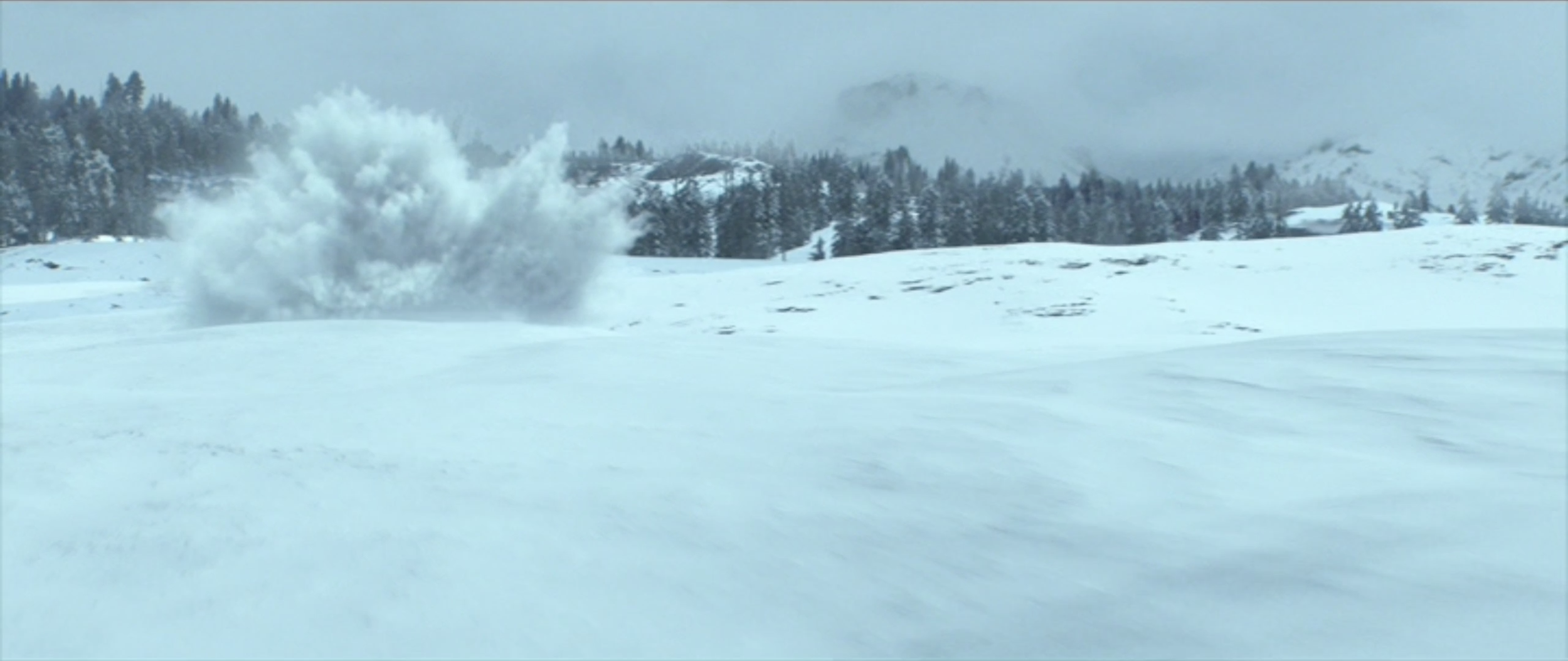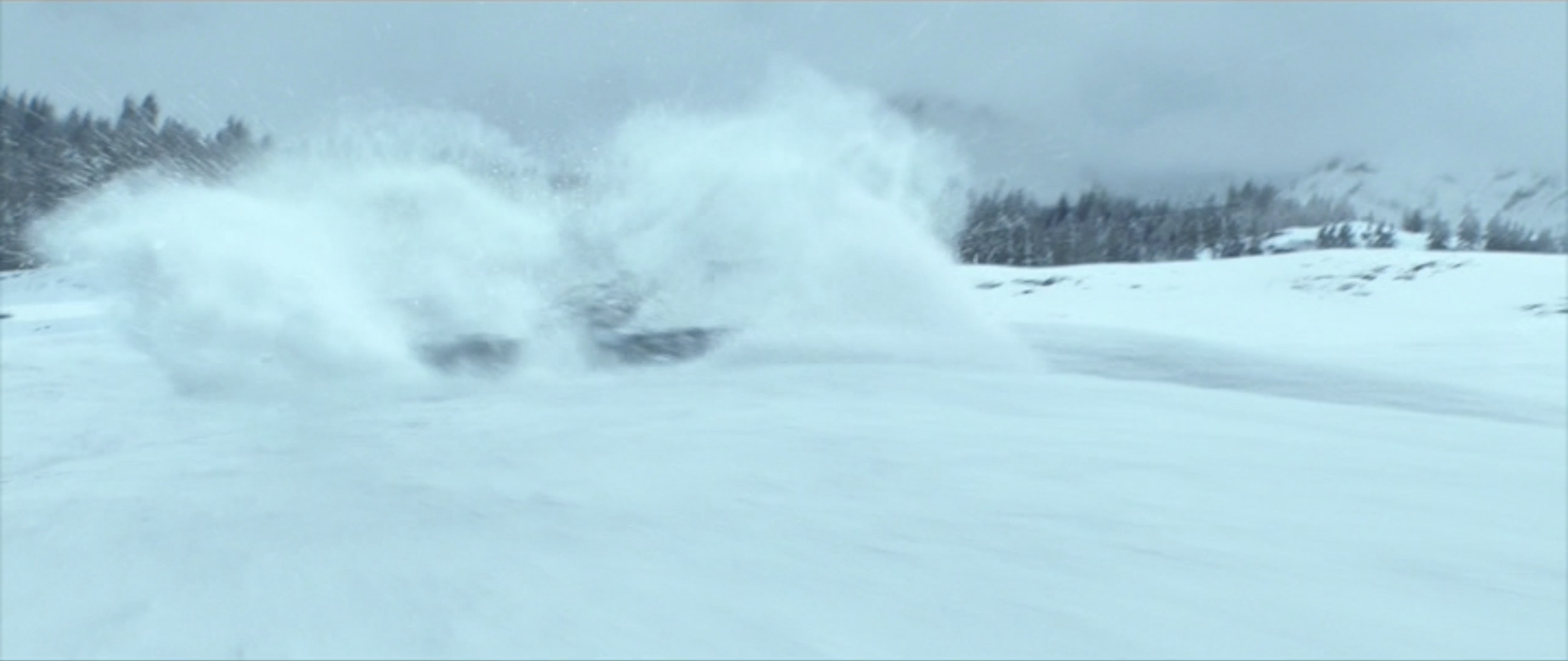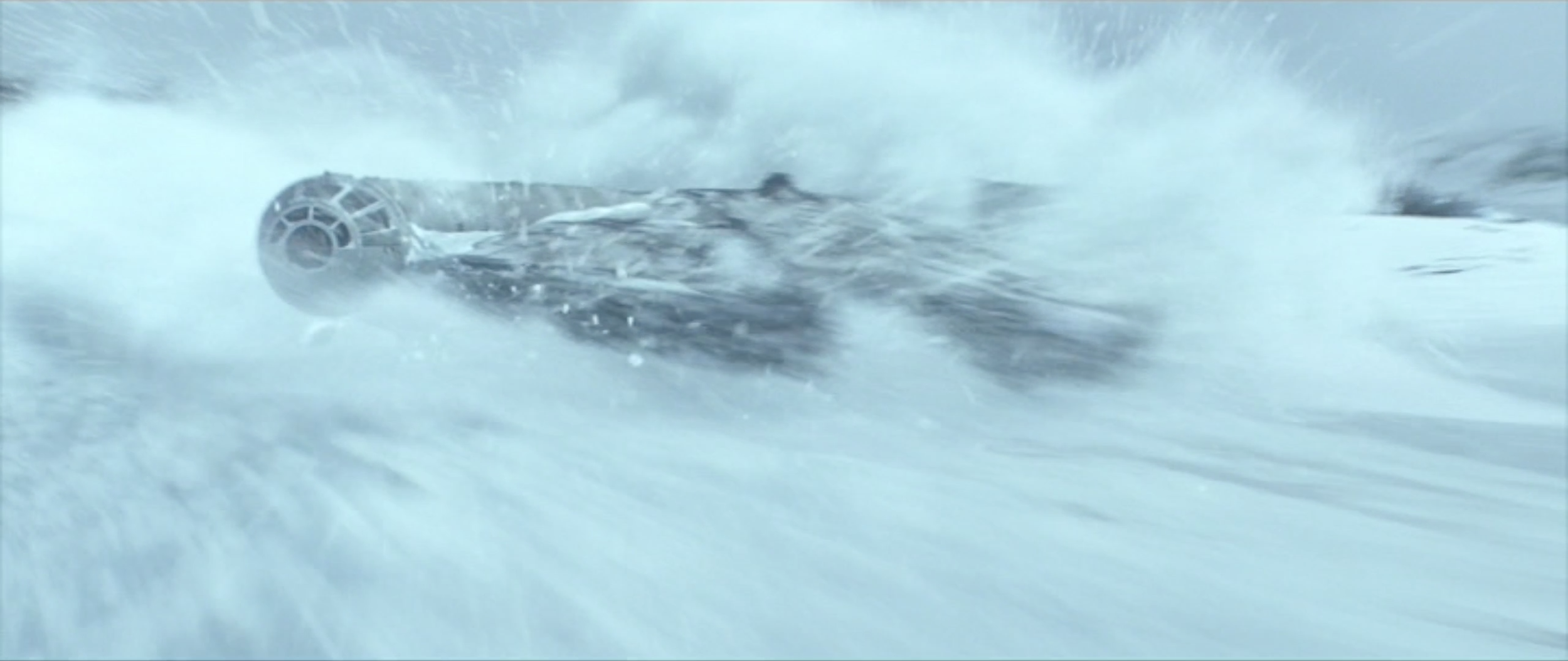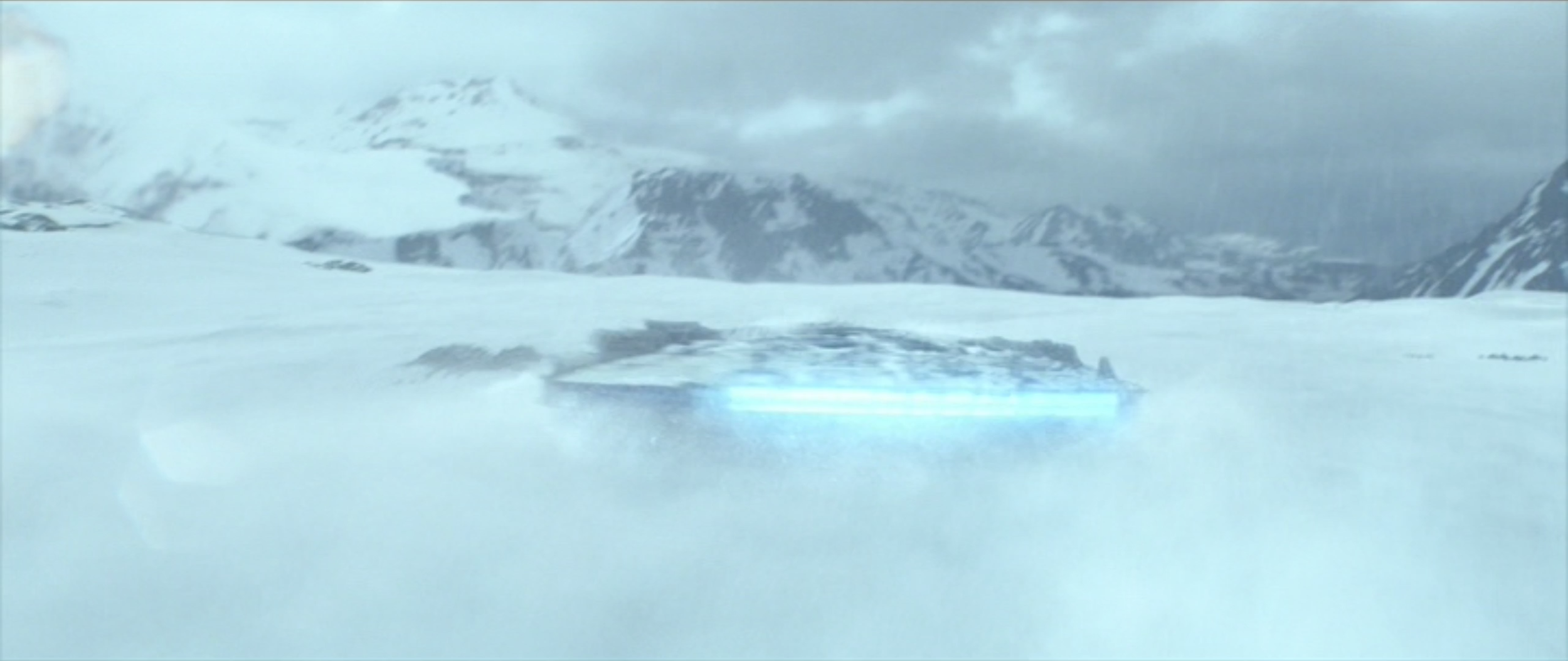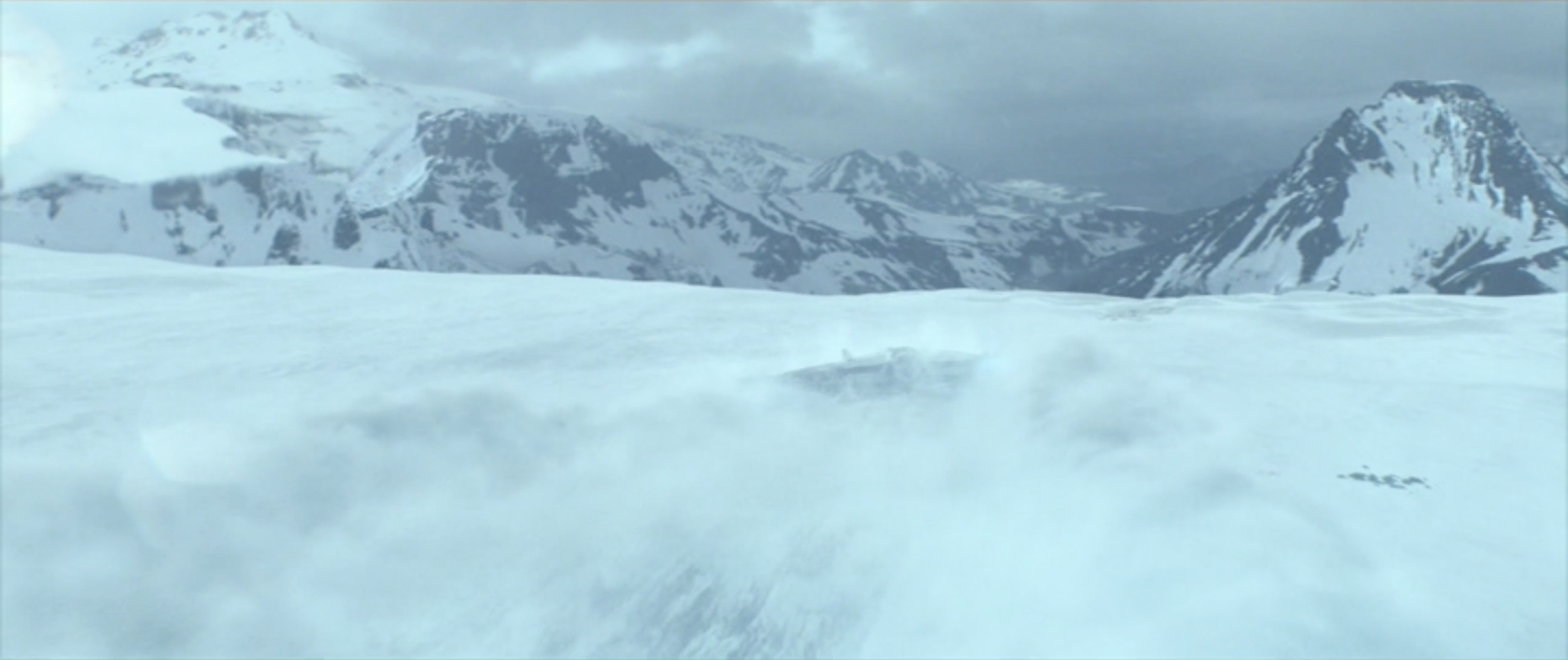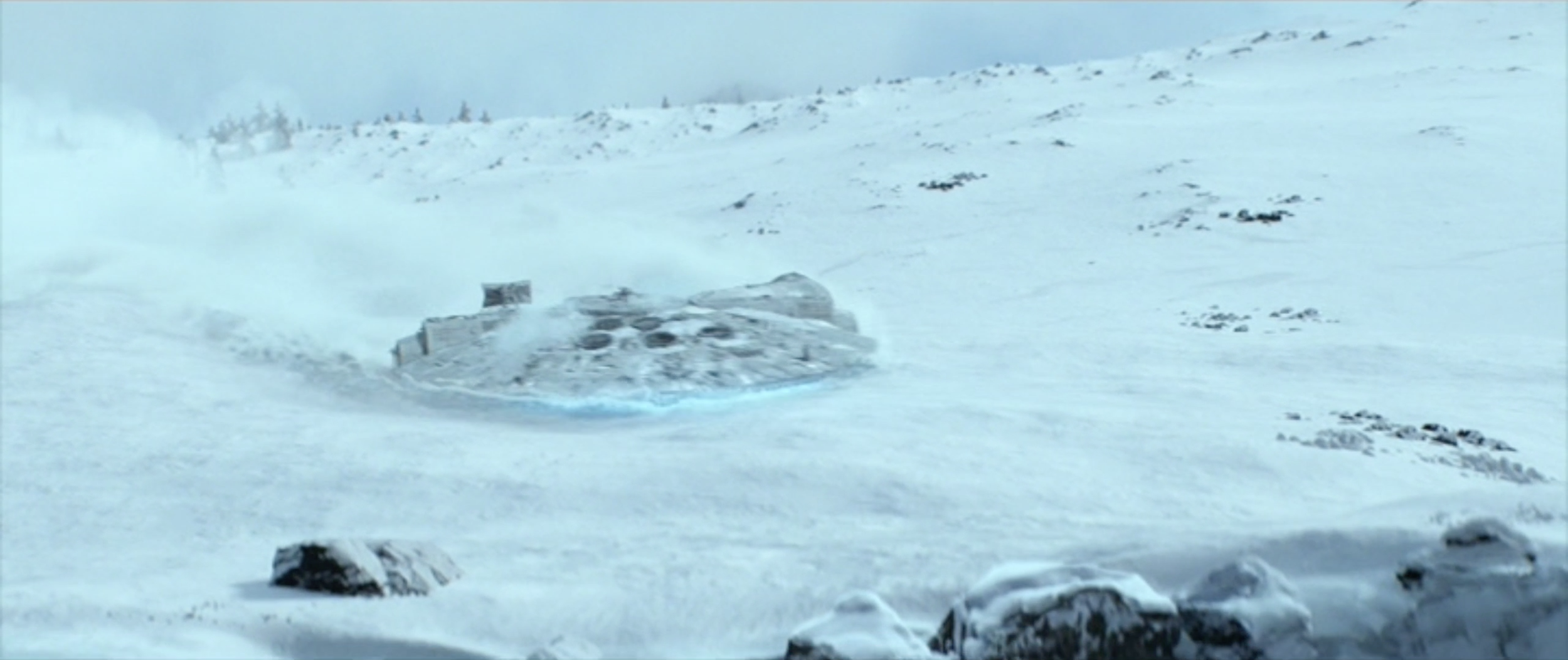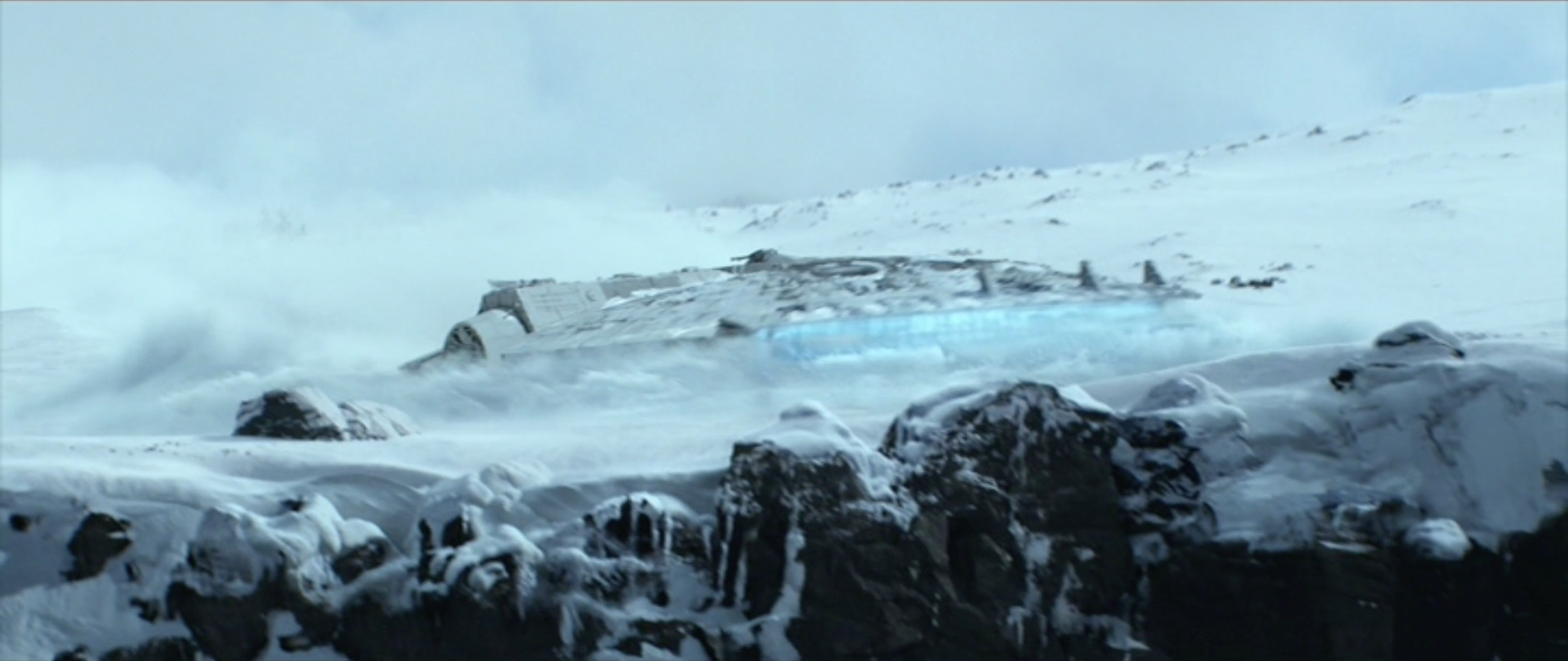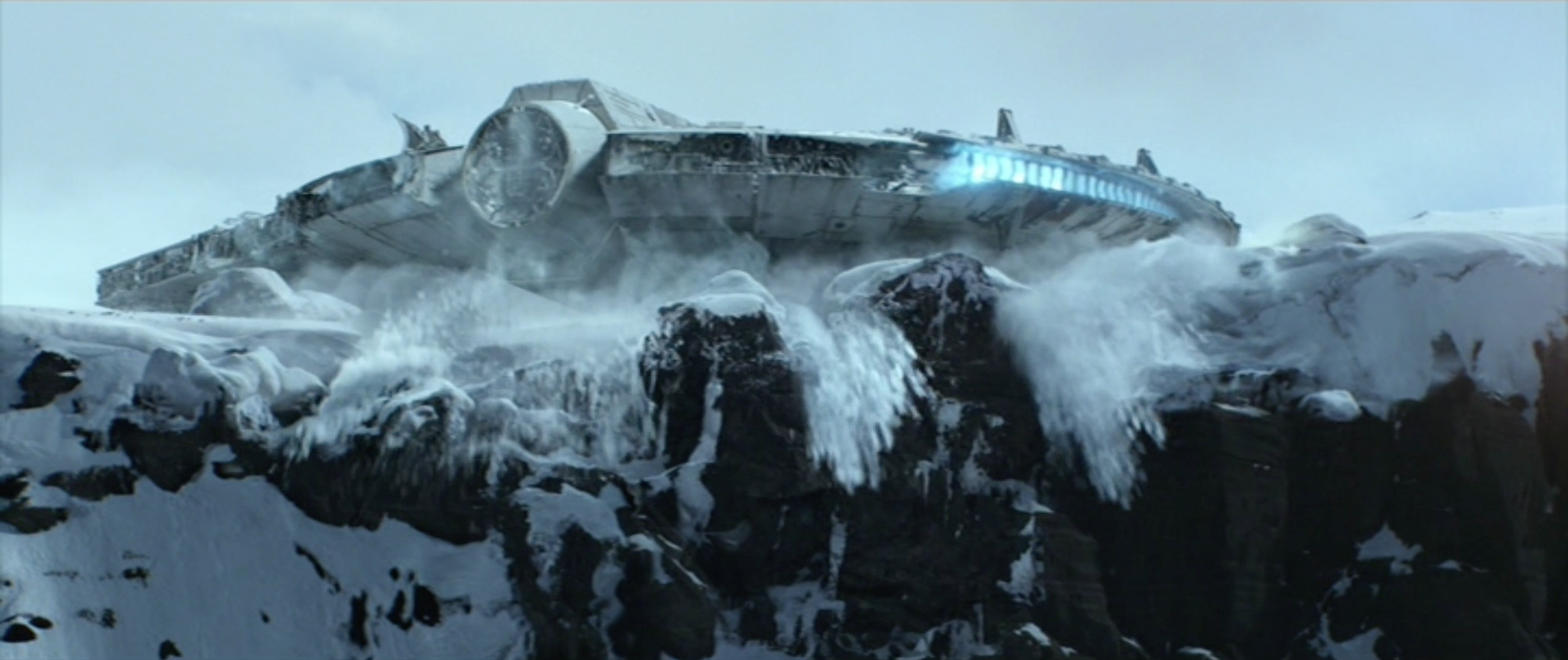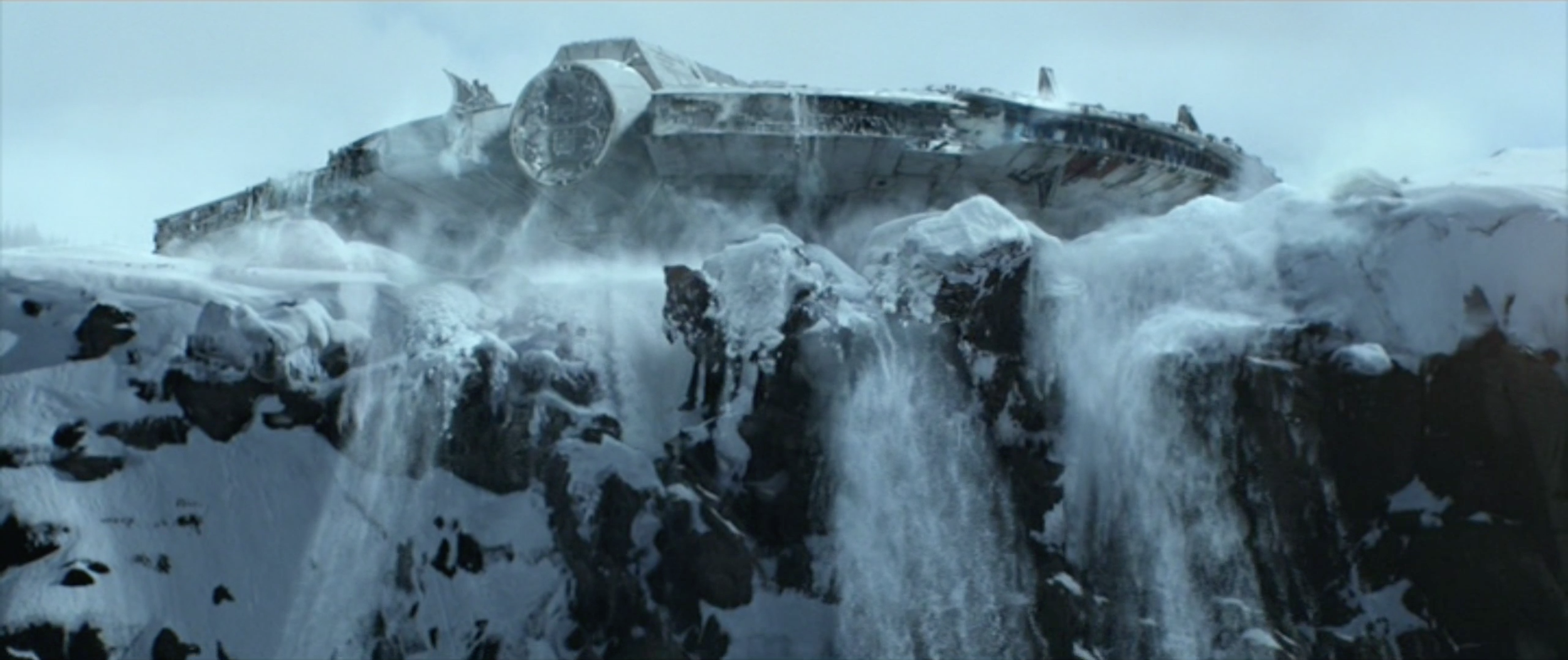









Star Wars: The Force Awakens
Star Wars: The Force Awakens
I did a lot of snow simulation for Star Wars: The Force Awakens. Probably too much. I spent almost the entirety of my stint on the show working on the sequence where the Millennium Falcon, carrying Han Solo and Chewbacca, crash lands onto the icy planet of Starkiller Base.



This was my first time simulating snow, and we had a new solver developed specifically to address the need to simulate snow and sand. The solver was in its infancy when I started work on my shots, so I ended up using a combination of the new solver and our traditional fluid simulation pipeline to get these shots done.
A unique aspect of snow which is difficult to capture with a traditional fluid solver is the chunkiness of dry snow and its interaction with other snow. Our new solver did a very nice job of replicating that chunkiness when the Millennium Falcon initially impacts on the planet surface.
The most difficult of the three shots I worked on was the one where the Falcon snowplows its way across the surface of the planet before finally coming to rest at the edge of a cliff. Though it may not seem like it, the Falcon travels a tremendous distance over the course of the shot, which makes any sort of simulation technique require significantly more time and system resources to iterate on. To complicate matters, the Falcon gets very close to camera, which necessitated using a sufficiently high simulation resolution, further adding to simulation iteration time.
The third shot was the last one I worked on and was a bit more straight-forward since I had already worked through the complications of the previous two shots. The new addition in this shot was generating the snowy chunks which get kicked off the cliff face, which was quite fun to do.
After finishing the snow sequence I finished off the project with an X-wing explosion shot, which you can see at the very end of the video below.

Jurassic World
Jurassic World
Jurassic World was a short project for me; I joined the project about halfway through so ended up working on a lot of miscellaneous effects. Among those effects were smoke, water, and blood simulation. The most exciting part of the project for me was participating in my first extras shoot.
Some of the most difficult effects shots to work on are the ones which get very close to camera. In the case of the Pteranodon attack sequence, I had to simulate the water and bubbles perturbed by a Pteranodon dunking Zara in and out of water all while flapping its wings right in front of camera.
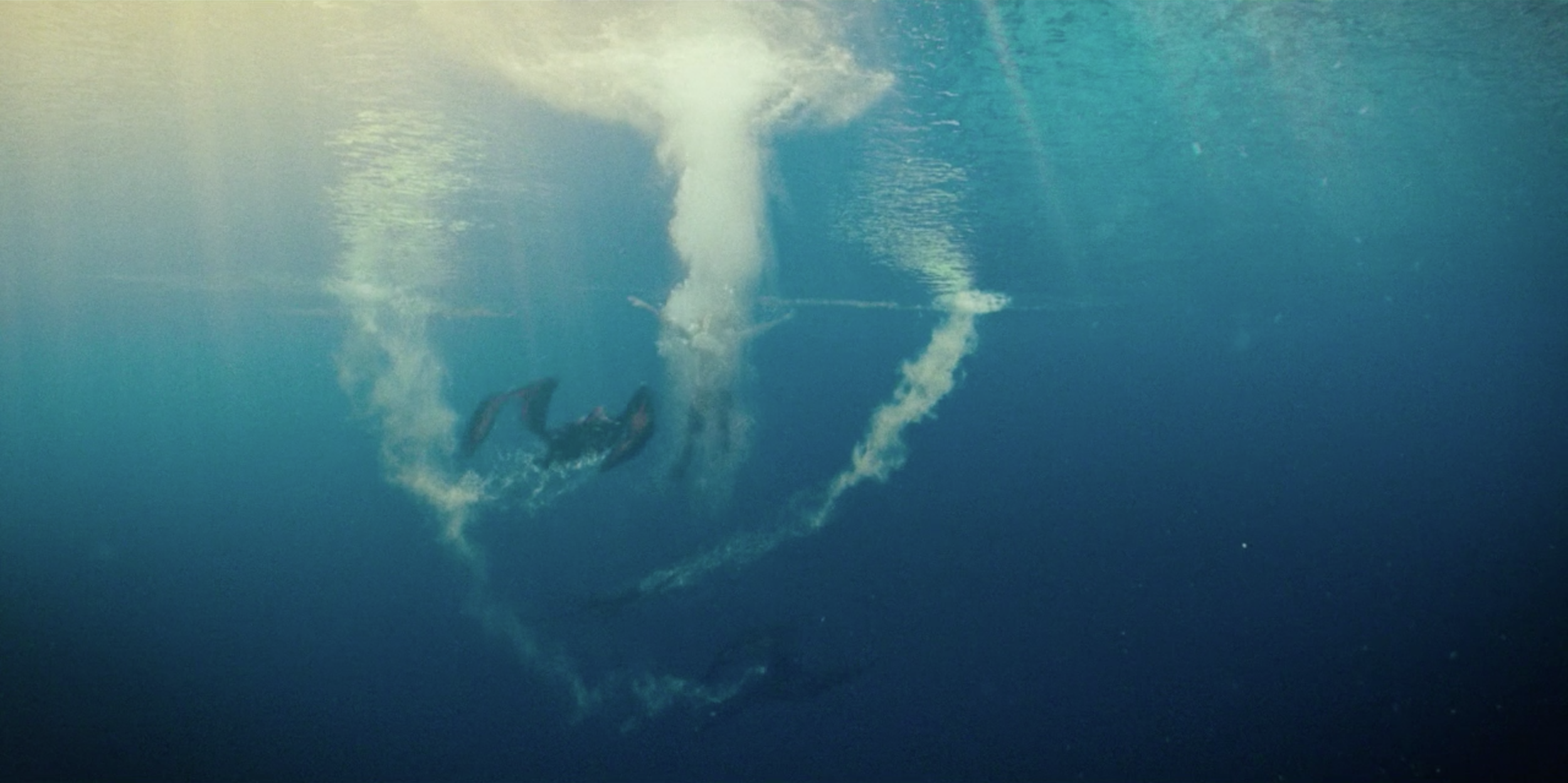
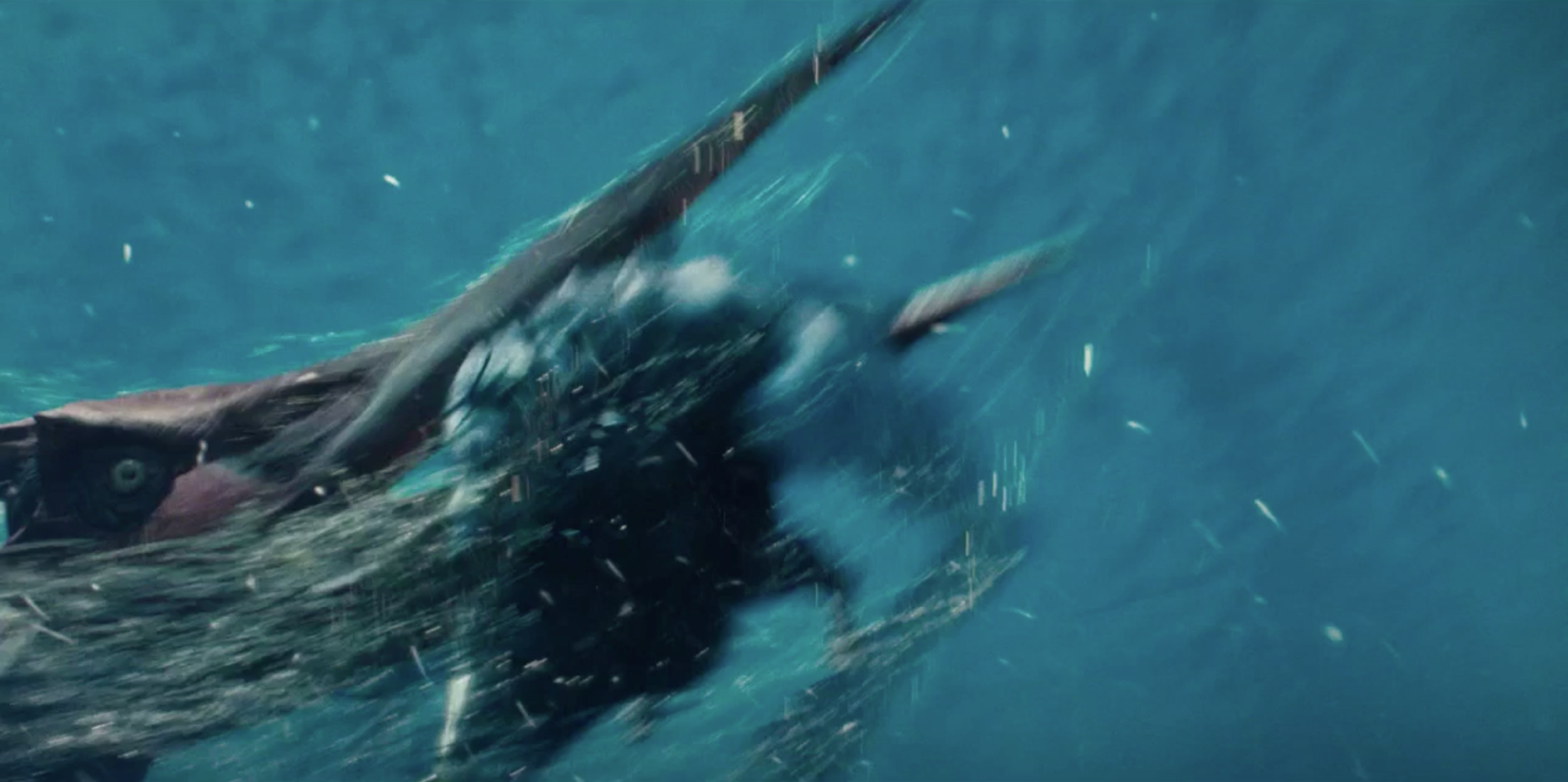
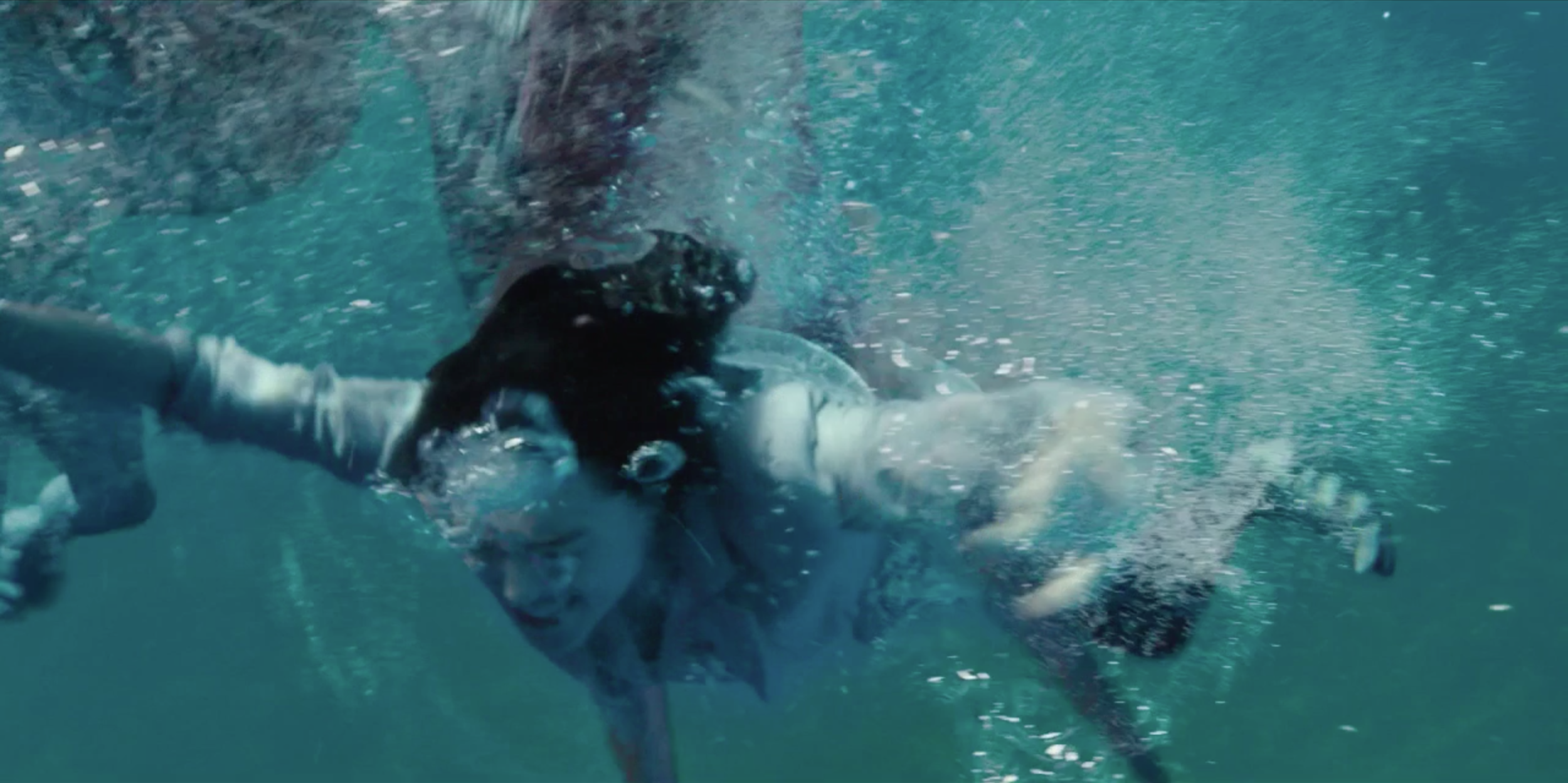
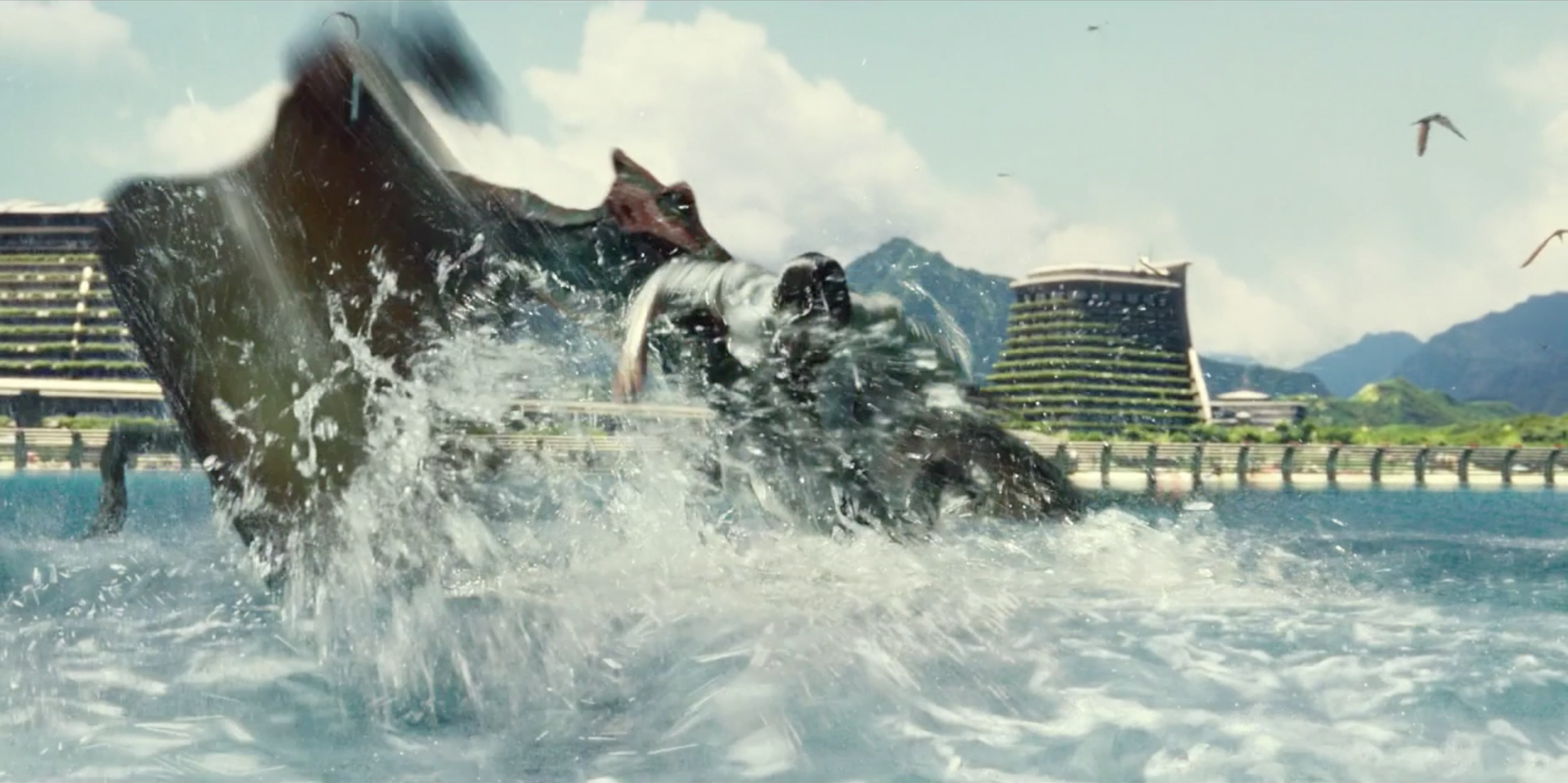
Here is my cameo as a park visitor. I'm at the top of the spiral staircase in the blue shirt closest to the dinosaur hologram's head.

Captain America: The Winter Soldier
Captain America: The Winter Soldier
Captain America: The Winter Soldier was my first movie as a sequence supervisor. My role as a sequence supervisor involved tracking progress of the shots in my sequence and making sure that comments from the VFX supervisor were being addressed in a timely manner.
Copyright © 2014 Marvel Studios
Copyright © 2014 Marvel Studios
In addition to supervising, I was on a small team of effects artists who worked on the climax of the film where three helicarriers destroy each other and fall out of the sky.
The bulk of my shot work on this movie involved explosions with all of the associated debris and smoke as well as a touch of water simulation. In the shot to the left, a helicarrier crashes into a reservoir which subsequently causes the underground hangars to flood.
Copyright © 2014 Marvel Studios
For me, the highlight of this project was working on an over-the-top Comic-Con trailer shot (shown here). It was my first shot of the film and I finished it in only four weeks.
Eventually it was cut from the film but it was in the first trailer, which you can watch below.
Copyright © 2014 Marvel Studios
The above Comic-Con shot appears at the end of this first trailer for the film.

Pacific Rim
Pacific Rim
Pacific Rim is a movie about Kaiju and mechs beating the crap out of each other. The majority of the effects work for my team was water-based. All of my shots were water simulation shots with the exception of the opening shot of the film, which was a combination of fires, bubbles, and a few other types of effects work.
© 2013 Warner Bros. Entertainment Inc. and Legendary Pictures Funding, LLC
This shot is one of the featured images on the Arnold Renderer website: https://www.solidangle.com/news/pacific-rim/
© 2013 Warner Bros. Entertainment Inc. and Legendary Pictures Funding, LLC
© 2013 Warner Bros. Entertainment Inc. and Legendary Pictures Funding, LLC
© 2013 Warner Bros. Entertainment Inc. and Legendary Pictures Funding, LLC
I created the portal at the bottom of the ocean where the Kaiju emerge from. This is the first shot of the film. The portal is a molten fiery energy which generates a lot of bubbles which get sucked back into the portal.
© 2013 Warner Bros. Entertainment Inc. and Legendary Pictures Funding, LLC
© 2013 Warner Bros. Entertainment Inc. and Legendary Pictures Funding, LLC

Cloud Atlas
Cloud Atlas
For Cloud Atlas I worked on the fast-paced chase sequence through the futuristic highways of Neo Seoul based in the year 2144.
I created the generic setup for all roads (also referred to as transways) in the Neo Seoul universe. Transways are translucent roads which help suspend and propel vehicles. The aesthetic of the transways is that of a smokey, delicate, yet stable energy field. They have a liquidy smoke layer with a sort of dissipative electrical energy as vehicles interact with it.
© 2012 Warner Bros. Entertainment Inc.
© 2012 Warner Bros. Entertainment Inc.
© 2012 Warner Bros. Entertainment Inc.

Battleship
Battleship
Though the bulk of the effects work on Battleship was water simulation, I was tasked with mostly smoke and pyrotechnic simulations.
I quickly became the go-to artist for wispy smoke and sparks generated from the alien "peg launchers" in the film. The enemy ships have munitions bays which launch explosive pegs in a mortar-like fashion which embed themselves in their targets and subsequently blow up. I carved out a niche as the artist for close-up shots of the pegs revving up to full speed and emitting a smokey haze.
© 2012 Universal Pictures
© 2012 Universal Pictures
The high point of this show for me was working on the eponymous "you sunk my battleship" shot -- over three-thousand frames of continuous destruction and mayhem as a battleship gets destroyed bit by bit. The shot concludes with an enemy shedder ripping the battleship completely in half. My work was just the explosive aspect of the sequence.
© 2012 Universal Pictures
© 2012 Universal Pictures
© 2012 Universal Pictures

Mission: Impossible- Ghost Protocol
Mission: Impossible- Ghost Protocol
I had a brief stint working on Mission: Impossible - Ghost Protocol. I only worked on a handful of shots, one of which was the destruction of the Kremlin at the beginning of film.
I thought it was funny that I, the only Russian effects artist I know of at ILM, was asked to blow up the symbolic capital of the Motherland. Situational irony or political agenda? Who knows and who cares.
My only work on these shots was the dust explosion and debris on and around the Kremlin.
© 2011 Paramount Pictures




Cowboys & Aliens
Cowboys & Aliens
Cowboys & Aliens was my first film as a Technical Director.
I was tasked with creating a generic sand and dust setup for interaction between the aliens and the desert environment. Any time an alien walked, ran, fell, or scrambled across the desert environment of the film, my simulation setup was used.
I also worked on the exhaust and initial take-off dust explosion of the shuttle launch shot at the end of the film. This particular shot required a decent amount of pipeline work in order to make manageable.
Copyright © 2010 Universal Pictures
Copyright © 2010 Universal Pictures
Copyright © 2010 Universal Pictures
Copyright © 2010 Universal Pictures

The Last Airbender
The Last Airbender
The Last Airbender was my first movie running shots at ILM.
I had been the effects department Assistant Technical Director (ATD) for about half a year before being given an opportunity to do some shot work, and my first assignment was water simulation. My primary role was still to support the effects pipeline tools, but I was very fortunate to get a chance to contribute to this project artistically as well as technically.
Copyright © 2010 Paramount Pictures
Copyright © 2010 Paramount Pictures
Copyright © 2010 Paramount Pictures
